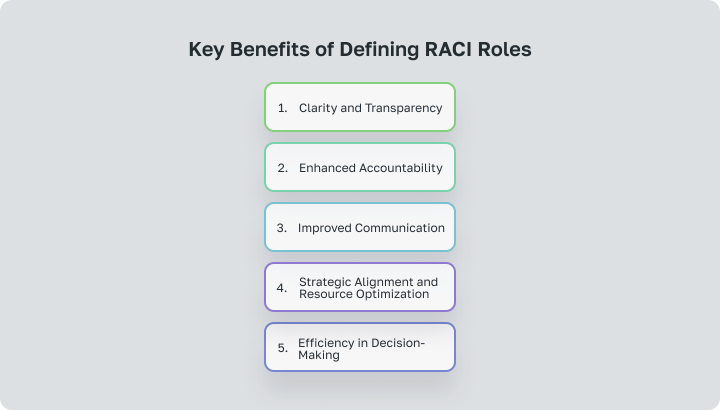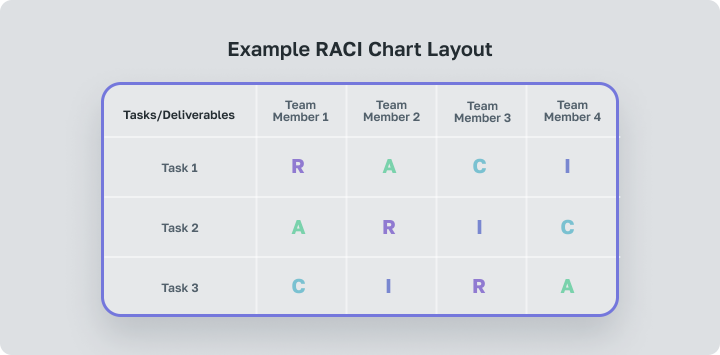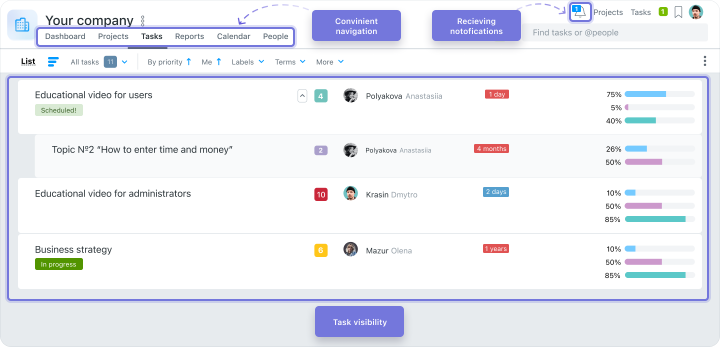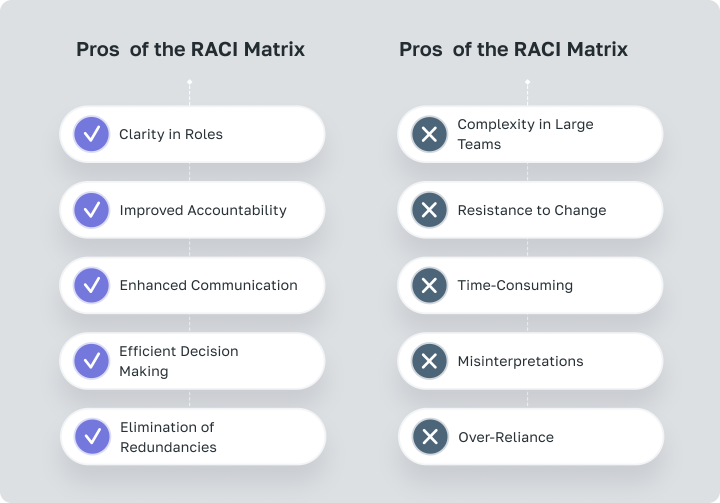In this article, we provide a solid explanation of what the RACI matrix is and how you can implement it into your workflow to improve project coordination.
Introduction to the RACI Matrix
Responsibility matrix is a critical project management tool that help define clear roles and responsibilities on a project. It streamlines communication and ensures that everyone on the team understands their responsibilities by identifying who is responsible, accountable, consulted, and informed for each task. This approach results in smoother project execution through the elimination of redundancy and confusion.
Understanding the RACI Matrix
What is a RACI matrix?
The RACI matrix, defined by the RACI acronym — Responsible, Accountable, Consulted, and Informed. RACI framework helps in clarifying who is directly responsible for completing the task, who is accountable for overseeing its success, who should be consulted during the process, and who should be in the loop on the results.

Let’s take a closer look at the acronym RACI definitions:
R — Responsible
This role is assigned to individuals or teams tasked with the execution of the work. They are the doers, whose hands-on efforts directly impact task completion. Multiple people can be responsible for different parts of a task, but clear division ensures organized execution.
A — Accountable
Often referred to as the “final approving authority,” this is the person who is ultimately answerable for the activity’s accurate and thorough completion. There must be exactly one person accountable for each task to avoid ambiguity regarding who signs off on work quality and completion.
C — Consulted
These are the specialists or experts who provide critical knowledge and expertise before a task is executed. Consulted parties are engaged through two-way communication to offer guidance that influences task outcomes. Their input is crucial for informed decision-making and typically involves individuals who can provide unique insights into the task.
I — Informed
Individuals in this category need to be kept updated on task progress and outcomes but do not contribute directly to the task execution. Keeping them informed ensures that relevant stakeholders are aware of project developments without cluttering decision-making processes. This is typically one-way communication.
By defining these roles within the RACI matrix, organizations can minimize overlap and confusion, ensuring that each task is handled efficiently with all necessary inputs and proper oversight, which enhances overall project coherence and accountability.
RACI vs RASCI: Understanding the Differences
The RACI and RASCI matrices are both tools used in project management to clarify the roles and responsibilities of team members, but they slightly differ in their components.
RASCI Matrix
The RASCI matrix includes all the elements of the RACI matrix with the addition of one extra role: S — Supportive
Individuals or groups who provide additional support to the Responsible person in the execution of the task. This can include providing resources, help in a secondary role, or any other support necessary for completing the task.
Key Differences
The main difference between the RACI and the RASCI matrix is the addition of the Support role in RASCI, which helps in recognizing the contributions of those who provide support and resources necessary to complete the tasks. This can be particularly useful in large projects where several teams or individuals contribute to the completion of a task indirectly by assisting those directly responsible for its execution.
Both matrices are used to increase transparency and streamline the communication process within the team by clearly defining who is responsible, accountable, consulted, and informed for every task. However, the choice between using RACI or RASCI often depends on the specific needs of the project and the level of detail required in outlining team roles. The additional “Supportive” role in RASCI is particularly beneficial in complex projects where multiple layers of support are common.
The Importance of RACI Roles in Project Management
By defining RACI roles, project managers can create a structured environment that not only enhances organizational clarity but also boosts operational efficiency. Here’s a deeper exploration into the significance of RACI roles and how they contribute to successful project outcomes.
Key Benefits of Defining RACI Roles:

- Clarity and Transparency: Clearly outlined roles in the RACI matrix improve transparency by defining who is responsible for what, reducing the chances of overlapping duties or neglected responsibilities.
- Enhanced Accountability: By designating a single accountable person for each task, the RACI model ensures there is always someone specifically responsible for the completion of each task, enhancing accountability throughout the project.
- Improved Communication: The Consulted and Informed roles within the RACI matrix facilitate better communication flow, ensuring that all stakeholders are appropriately updated and able to provide input where necessary.
- Efficiency in Decision-Making: Clear roles allow for quicker decision-making, as it is always clear who has the authority to make decisions and who needs to be consulted or informed about those decisions.
- Strategic Alignment and Resource Optimization: Ensures tasks align with strategic goals and optimizes resource allocation by matching tasks with appropriate personnel skills, improving project outcomes and resource use.
Creating an Effective RACI Matrix
Creating a project management responsibility matrix can streamline your workflow and ensure that all project roles are clear. Here’s how to develop a RACI matrix for your project:
Steps to Create a RACI Matrix
To create a RACI Matrix effectively, follow these steps for clarity and comprehensive coverage of roles and tasks within your project.
 List Tasks and Deliverables
List Tasks and Deliverables
Begin by identifying all the tasks, activities, and key deliverables your project entails. This list forms the foundation of your RACI matrix, ensuring that every crucial component of the project is accounted for and assigned.
 Identify Project Roles
Identify Project Roles
Catalog all project stakeholders, team members, and any individuals who influence or are impacted by the project. This includes everyone from project sponsors and team leaders to external consultants. Clearly defining the involvement of each stakeholder ensures that responsibilities are assigned accurately.
 Assign RACI Roles:
Assign RACI Roles:
- Responsible Assign individuals who will execute the task. This role is typically hands-on, with team members tasked with the direct completion of the task.
- Accountable Designate who is ultimately accountable for the task’s correct and timely completion. This is often a project manager or team lead. There should be exactly one accountable person to avoid confusion.
- Consulted Identify experts or stakeholders who should be consulted to provide insights and information necessary for task completion. This input is crucial for informed decision-making.
- Informed List those who need updates on the progress or outcomes of the tasks. Keeping them informed helps maintain organizational transparency and can aid in downstream or parallel project activities.
 Review and Adjust
Review and Adjust
Once the initial RACI matrix setup is completed, review it with your team to ensure all roles and responsibilities are understood and agreed upon. This review is critical to confirm that no tasks are overlooked and that responsibilities are evenly distributed without overburdening any single project member.

![]() Iterate and Update
Iterate and Update
As the project progresses, it may be necessary to revisit and adjust the RACI matrix. Changes in project scope, tasks, or team composition can necessitate updates to ensure the matrix remains relevant and effective throughout the project lifecycle.
RACI Matrix Template
A typical RACI matrix template will have rows representing tasks or deliverables and columns representing team members or stakeholder roles. Each cell in the matrix is filled with one of the RACI codes to specify the relationship of the role to the task.

This structure helps in visualizing the distribution of roles and ensures that each aspect of the project is covered by appropriate team members.
By following these guidelines and using a well-structured template, organizations can effectively implement a RACI matrix to enhance project coordination, accountability, and overall project success.
Implementing a RACI Matrix: Best Practices and Tips
FAQ: How to Implement a RACI Matrix
Here are FAQs to guide you on implementing a RACI Matrix effectively in your projects:
 What is the first step in implementing a RACI Matrix?
What is the first step in implementing a RACI Matrix?
Begin by clearly defining the scope and all tasks of your project. Breaking down the project into specific tasks or deliverables is critical to accurately assign roles.
 Can roles overlap in a RACI Matrix?
Can roles overlap in a RACI Matrix?
While some overlap is possible, particularly in smaller teams, it’s important to keep it minimal. Ensure that each role’s responsibilities are clear to avoid confusion and ensure accountability.
 How do you handle changes in team structure or project scope?
How do you handle changes in team structure or project scope?
Review and update RACI’s on a regular basis to account for changes in team structure or project scope. Adjustments might be needed if new tasks arise or if there are shifts in team membership or leadership.
 What are common pitfalls when using a RACI Matrix?
What are common pitfalls when using a RACI Matrix?
Common pitfalls include over-complication, failing to update the matrix as projects evolve, and lack of communication about assigned roles. Avoid these by keeping the matrix simple, reviewing it regularly, and openly discussing it with all stakeholders.
 What tools can help in maintaining a RACI Matrix?
What tools can help in maintaining a RACI Matrix?
Project management software like Microsoft Project, Asana, or Worksection can help in creating and maintaining a RACI Matrix. These tools allow for easy updates and visibility, which are essential for dynamic project environments.
Best Practices for Each RACI Role
To effectively implement a RACI Matrix, it’s crucial that each role — Responsible, Accountable, Consulted, and Informed — is executed with precision. Here are some best practices to ensure each role is clearly understood and effectively managed:
- Responsible Ensure those assigned are capable and have the necessary resources. Regularly update them on task expectations and deadlines.
- Accountable Must have a clear overview of the project’s progress and be ready to step in if issues arise. They should be decision-makers or have direct access to those who make decisions.
- Consulted Chosen for their expertise, they should be utilized efficiently to provide advice without slowing down the decision-making process.
- Informed Keep them updated through regular communications. Use automated tools to send updates to avoid task overload on the responsible team.
RACI Matrix in Action: Examples and Case Studies
Example 1: Software Development Project 
In a software development project aimed at launching a new application, a RACI matrix was used to define clear roles:
- Project Manager: Accountable for overseeing the project’s progress and making strategic decisions.
- Software Developers: Responsible for executing development tasks.
- IT Security Team: Consulted for security measures and compliance checks.
- Client: Informed of progress at key milestones.
This structured role assignment ensured that the development process was smooth, with timely deliveries and adherence to security standards, resulting in a successful on-time and within-budget project delivery.
Example 2: Marketing Campaign 
A RACI matrix was pivotal in managing a marketing campaign for a new product launch:
- Marketing Manager: Accountable for the overall success and coherence of the campaign.
- Creative Team: Responsible for designing and creating marketing materials.
- Legal and Compliance Teams: Consulted to ensure all materials met regulatory requirements.
- Sales Team: Informed of campaign progress to align sales strategies with marketing efforts.
This approach ensured that all materials were not only creative but also compliant with legal standards, facilitating a unified and effective marketing campaign that significantly boosted product awareness.
Choosing Project Management Software for RACI Matrix
Features to Look for in Software
When selecting project management software that supports the implementation of the RACI matrix, it’s crucial to focus on features that facilitate clear communication, role assignment, and task visibility. Key functionalities should include:

- Role Definition Capabilities: Software should allow for the easy definition and assignment of roles (Responsible, Accountable, Consulted, Informed) to team members.
- Task Visibility: Tools need to offer comprehensive views that detail who is responsible for what, ensuring all team members are informed and accountable.
- Notification Systems: Automated alerts and notifications are essential to keep all relevant parties updated on changes or completions of tasks associated with the RACI matrix.
- Collaborative Workspaces: The platform should provide spaces where team members can collaborate effectively, making it easier to consult and inform others as per the matrix requirements.
- Integration Options: Effective integration with other tools and systems can help streamline various aspects of project management and ensure seamless communication across platforms.
Popular Tools: Worksection and Others
Various project management tools, including Worksection, Asana, Trello, and Microsoft Project, offer robust support for the RACI matrix, each with unique capabilities. Worksection features an intuitive interface that simplifies the complexities of project management and supporting the RACI framework.

It allows users to clearly define and assign roles, enhancing task visibility and ensuring every team member is aware of their responsibilities. With its robust notification systems and easy navigation, Worksection keeps all parties informed and aligned with project goals. Its capability to integrate with various communication tools and data systems makes it a versatile choice for teams aiming for fluid collaboration and data coherence.
Other platforms might also accommodate RACI matrix functionalities but differ in interface complexity and integration features. Some provide extensive customization options and sophisticated analytics, making them ideal for larger organizations or those with specialized requirements that extend beyond straightforward RACI implementation. Worksection is an excellent option for teams that value simplicity and effectiveness in their project management practices, with its easy-to-use approach and comprehensive feature set.
Advantages and Challenges of the RACI Matrix
Pros and Cons of the RACI Matrix
The RACI matrix offers structured clarity in project management but also presents some challenges. Here are the key advantages and challenges:

Advantages
Clarity in Roles: The RACI matrix clearly delineates who is responsible, accountable, consulted, and informed for each task, reducing confusion and overlapping duties.
Improved Accountability: By assigning specific roles to team members, it becomes easier to track performance and hold individuals accountable for their part in the project.
Enhanced Communication: By specifying who needs to be consulted and who should be informed, the RACI matrix ensures that all necessary communication lines are open, enhancing overall project communication.
Efficient Decision Making: With clear accountability, decisions can be made swiftly and effectively, often leading to faster project delivery.
Elimination of Redundancies: By clearly outlining responsibilities, the matrix helps to avoid duplication of effort, thereby increasing efficiency.
Challenges
Complexity in Large Teams: In projects with many stakeholders, the matrix can become complex and cumbersome, making it difficult to manage.
Resistance to Change: Some team members may resist the structured nature of the matrix, preferring more flexibility in their roles and responsibilities.
Time-Consuming: Setting up a comprehensive RACI matrix can be time-consuming, especially in large or complex projects.
Misinterpretations: If not clearly defined, the roles within the RACI matrix can be misinterpreted, leading to confusion and inefficiencies.
Over-Reliance: There’s a risk of over-reliance on the matrix to define roles and responsibilities, which may stifle innovation and adaptability within the team.
Conclusion
The RACI matrix is a powerful tool in project management, known for its ability to bring order and clarity to roles and responsibilities. While it offers significant benefits like improved accountability and communication, it is not without its challenges, such as potential complexity and resistance from team members.
However, when implemented effectively, the RACI matrix can be an invaluable asset in helping project managers run more efficient, organized, and successful projects. Using this tool requires a thoughtful approach that balances its structured benefits with the dynamic needs of the project and its team.